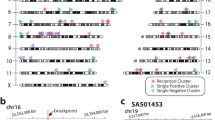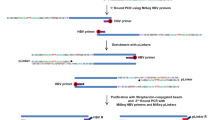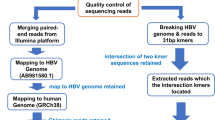Abstract
Proviral tagging has been used in animals as a powerful tool for cancer genetics. We show that a similar approach is possible in patients with hepatocellular carcinoma (HCC) infected by Hepatitis B Virus (HBV), a human pararetrovirus which may act by insertional mutagenesis. In this work, the HBV genome is used as a probe to identify cancer-related genes. By using HBV-Alu-PCR, we obtained 21 HBV/cellular DNA junctions from 18 different patients. In six of 21, we found the HBV DNA integrated into a cellular gene: (1) Sarco/Endoplasmic Reticulum Calcium ATPase1 Gene; (2) Thyroid Hormone Receptor Associated Protein 150 alpha Gene; (3) Human Telomerase Reverse Transcriptase Gene; (4) Minichromosome Maintenance Protein (MCM)-Related Gene; (5) FR7, a new gene expressed in human liver and cancer tissues; and (6) Nuclear Matrix Protein p84 Gene. Seven junctions contained unique cellular sequences. In the remaining eight, the HBV DNA was next to repetitive sequences, five of them of LINE1 type. The cellular genes targeted by HBV are key regulators of cell proliferation and viability. Our results show that studies on HBV-related HCCs allow to identify cellular genes involved in cancer. We therefore propose this approach as a valuable tool for functional cancer genomic studies in humans.
This is a preview of subscription content, access via your institution
Access options
Subscribe to this journal
Receive 50 print issues and online access
$259.00 per year
only $5.18 per issue
Buy this article
- Purchase on Springer Link
- Instant access to full article PDF
Prices may be subject to local taxes which are calculated during checkout





Similar content being viewed by others
References
Berasain C, Patil D, Perara E, Huang SM, Mouly H, Brechot C . 1998 Oncogene 16: 1277–1288
Berridge MJ, Bootman MD, Lipp P . 1998 Nature 395: 645–648
Brechot C, Gozuacik D, Murakami Y, Paterlini-Brechot P . 2000 Semin. Cancer Biol. 10: 211–231
Buendia MA . 1992 Semin. Cancer Biol. 3: 309–320
Cecconi F, Meyer BI . 2000 FEBS Lett. 480: 63–71
Chami M, Gozuacik D, Lagorce D, Brini M, Falson P, Peaucellier G, Pinton P, Lecoeur H, Gougeon ML, le Maire M, Rizzuto R, Brechot C, Paterlini-Brechot P . 2001 J. Cell Biol. 153: 1301–1314
Chami M, Gozuacik D, Saigo K, Capiod T, Falson P, Lecoeur H, Urashima T, Beckmann J, Gougeon ML, Claret M, Maire M, Brechot C, Paterlini-Brechot P . 2000 Oncogene 19: 2877–2886
Chisari F . 1995 Hepatology 22: 1316–1325
Dejean A, Bougueleret L, Grzeschik KH, Tiollais P . 1986 Nature 322: 70–72
Durfee T, Mancini MA, Jones D, Elledge SJ, Lee WH . 1994 J. Cell Biol. 127: 609–622
Evans MJ, Carlton MB, Russ AP . 1997 Trends. Genet. 13: 370–374
Fourel G, Tiollais P . 1994 Primary Liver Cancer: Etiological and progression factors Bréchot C (ed) CRC Press: London pp. 89–124
Freeman A, Morris LS, Mills AD, Stoeber K, Laskey RA, Williams GH, Coleman N . 1999 Clin. Cancer Res. 5: 2121–2132
Garcia M, De Thé H, Tiollais P, Samarut J, Dejean A . 1993 Cell Biology 90: 89–93
Hanahan D, Weinberg RA . 2000 Cell 100: 57–70
Ito M, Yuan CX, Malik S, Gu W, Fondell JD, Yamamura S, Fu ZY, Zhang X, Qin J, Roeder RG . 1999 Mol. Cell 3: 361–370
Horikawa I, Barrett JC . 2001 cis. Activation of the human telomerase gene (htert) by the hepatitis b virus genome J. Natl. Cancer Inst. 93: 1171–1173
Johnson P . (1994) Primary Liver Cancer: Etiological and progression factors Bréchot C (ed) CRC Press: London pp. 31–40
Jonkers J, Berns A . 1996 Biochim. Biophys. Acta. 1287: 29–57
Largaespada DA . 2000 Leukemia 14: 1174–1184
Li J, Shen H, Himmel KL, Dupuy AJ, Largaespada DA, Nakamura T, Shaughnessy Jr JD, Jenkins NA, Copeland NG . 1999 Nat. Genet. 23: 348–353
Lin KH, Shieh HY, Chen SL, Hsu HC . 1999 Mol. Carcinog. 26: 53–61
Liu K, Hodes RJ, Weng N . 2001 J. Immunol. 166: 4826–4830
Matsubara K, Tokino T . 1990 Mol. Biol. Med. 7: 243–260
Meyerson M . 2000 J. Clin. Oncol. 18: 2626–2634
Minami M, Poussin K, Brechot C, Paterlini P . 1995 Genomics 29: 403–408
Musahl C, Holthoff HP, Lesch R, Knippers R . 1998 Exp. Cell Res. 241: 260–264
Robinson WS, Miller RH, Marion PL . 1987 Hepatology 7: 64S–73S
Schluter V, Meyer M, Hofschneider P . 1994 Oncogene 9: 1–10
Todorov IT, Werness BA, Wang HQ, Buddharaju LN, Todorova PD, Slocum HK, Brooks JS, Huberman JA . 1998 Lab. Invest. 78: 73–78
Tye BK . 1999 Annu. Rev. Biochem. 68: 649–686
Wang J, Chenivesse X, Henglein B, Brechot C . 1990 Nature 343: 555–557
Acknowledgements
This work was supported by grants from INSERM, (Institut National de Santé et Recherche Médicale), LNC (Ligue Nationale contre le Cancer), ARC, (Association pour la Recherche contre le Cancer).
Author information
Authors and Affiliations
Corresponding author
Rights and permissions
About this article
Cite this article
Gozuacik, D., Murakami, Y., Saigo, K. et al. Identification of human cancer-related genes by naturally occurring Hepatitis B Virus DNA tagging. Oncogene 20, 6233–6240 (2001). https://doi.org/10.1038/sj.onc.1204835
Received:
Revised:
Accepted:
Published:
Issue Date:
DOI: https://doi.org/10.1038/sj.onc.1204835
Keywords
This article is cited by
-
HBV genome-enriched single cell sequencing revealed heterogeneity in HBV-driven hepatocellular carcinoma (HCC)
BMC Medical Genomics (2022)
-
Clinical Implications and Management of Chronic Occult Hepatitis B Virus Infection
Current Hepatology Reports (2017)
-
Whole-genome sequencing of liver cancers identifies etiological influences on mutation patterns and recurrent mutations in chromatin regulators
Nature Genetics (2012)
-
Genome-wide survey of recurrent HBV integration in hepatocellular carcinoma
Nature Genetics (2012)
-
DNA double-strand breaks, potential targets for HBV integration
Journal of Huazhong University of Science and Technology [Medical Sciences] (2010)



